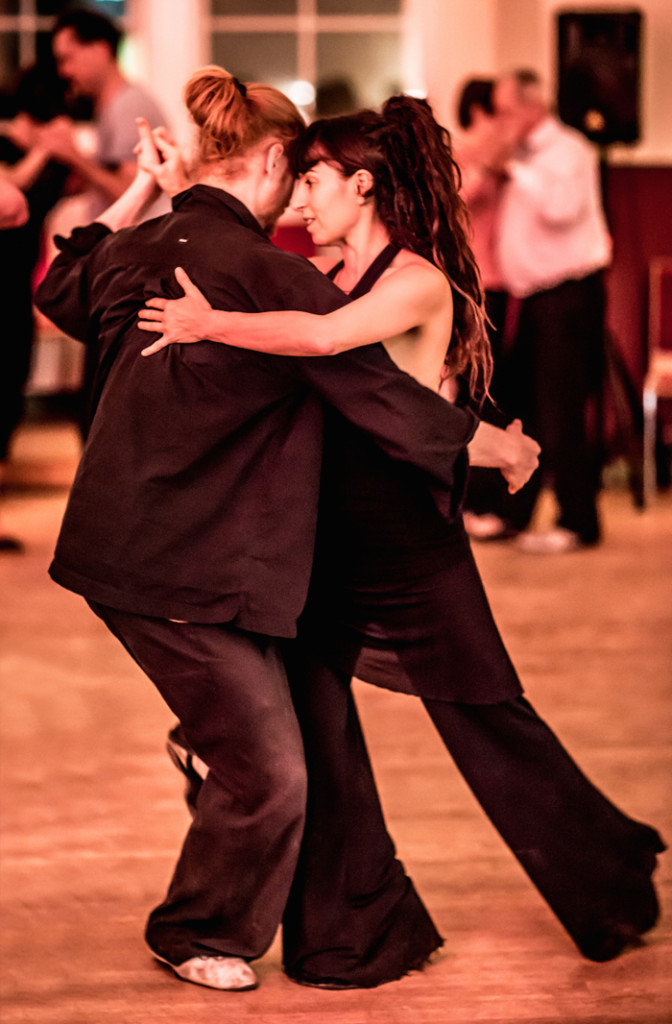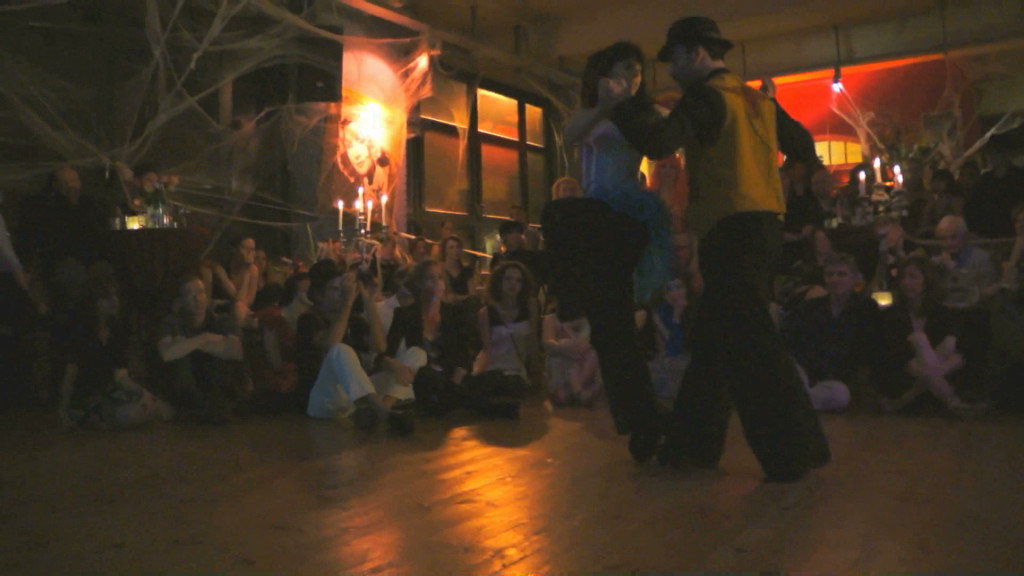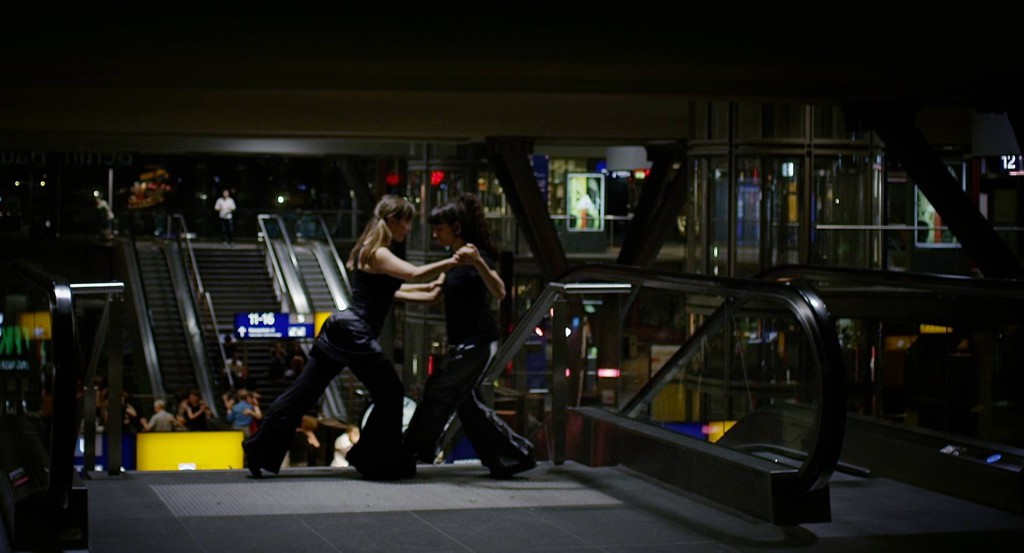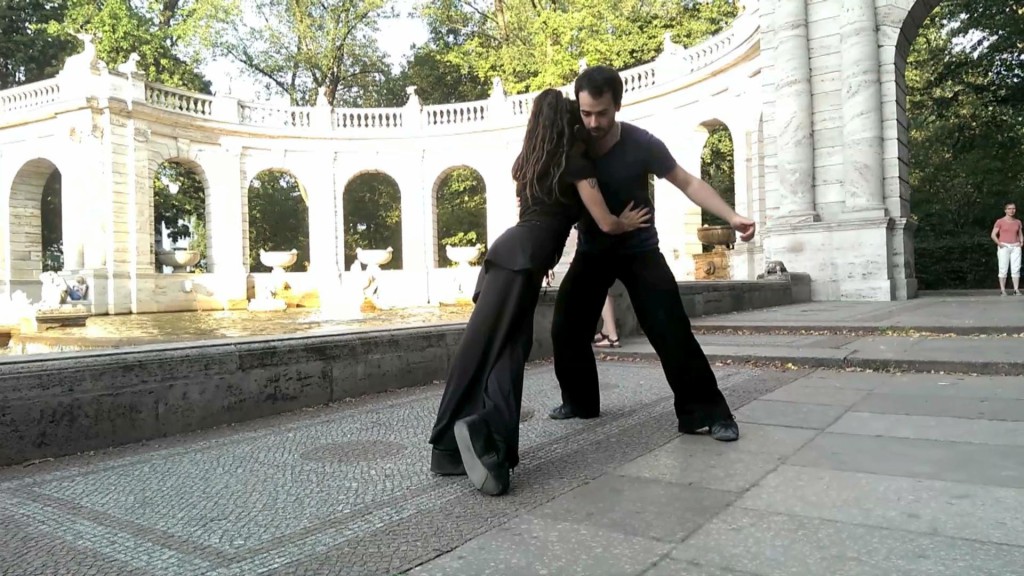Interview by Mona
1. Tell me the story behind your tango.
When I saw the film, “The Tango Lesson”, I knew that I would dance tango. Some years later –which is now 10 years ago– the moment arrived. I ask myself all the time why do I keep going. The reason is not anymore addiction, which passed about one year ago. Part of why I continue is that I don’t know what other people do at night. Another part is to try to discover what tango means to me, what this journey is about.

2. What made you look for more than traditional tango?
After my first teacher, I looked for a new maestra and I watched videos of all the world class dancers of that time and I chose the one with the most beautiful quality of movement. But I don’t think I have ever looked for more than traditional tango. And I don’t believe that I do much more than traditional tango. I’ve always been an athlete, so I dance with a lot of muscle and power and flexibility. I dance traditional tango at the extreme of physicality; that’s the only way it makes sense to me. Why should I not use my body fully? Recently, I have added something to the dance, which is to connect to the music autonomously before connecting to my partner. But once I enter the tango connection, it’s the same that everyone else is doing.
I believe a lot of what gets called “style” is really about level. If I am dancing with a beginner mark who has no understanding yet of the arch of connection, I’m going to be more comfortable in open embrace so I can control my body, than in close embrace, where he will undoubtedly hurt me and I will have to work too hard to compensate for his lack of skill. All the bigoted talk about “nuevo tango” is really criticism of low-level dancers who make ugly ganchos, don’t understand or can’t handle traffic, and don’t yet have the skills to maintain connection. If you look at the top professional dancers in the world who get described as “milonguero” or “salon”, their embrace is changing all the time, and they are using the whole tango lexicon from the 1940s. But for some reason, if amateur dancers do the same moves as visiting superstars, the bigoted local tango authorities (who invited same superstars to teach workshops) will derogate you. This “smug tango” is happening all over the world at the moment. Berlin just has a bigger community of people who won’t be bullied and want to find their own “authenticity” in tango.
WATCH! Vio y Germain Cascales, 3rd Tanda, Berlin, 20.August 2015
3. How do you see yourself dancing in five years?
Tango is an energy in my life that is taking me on a journey beyond my own capacity for imagination.
4. Considering your skills, how easy is to adapt to your leader during a milonga?
So easy that I don’t even know what you are talking about. To me all tango is the same. The only difference is level. I’m not picky about a mark’s level in terms of which movements he does, but I won’t dance with a man who doesn’t maintain hip flexion. It makes me work too hard to compensate the timing of the steps. And I can’t enjoy men who mark with their right hand. Violating my spinal column and depriving me of muscular integrity is not a nice basis for a relationship.
5. What brings students to your classes/workshops?
Most students come to me because they have read something on my blog. Some are attracted to the rationality of my precise anatomical biomechanics, some to the colorful and happy imagery of TangoForge, and some are iconoclasts who feel affirmed by my values of inclusivity and courage. In Berlin a lot of people really love our dancing and they want to learn what we are doing.
I am always happy to have dancers of all levels in my classes. When I dance at the highest level I am concentrating on the biomechanics of the arch of connection, transfer of weight, and projection – the same tools I teach to beginners in the first lessons. Dancers at all levels increase their strength, clarity, and quality of motion by constantly improving the tools that every movement relies upon. Pedagogically, I believe it’s best to expose new people to fancy moves so they will be interested, and to big moves like ganchos which are quicker and easier to learn than the tango conventions. The hardest things in tango are the front walk, solo foot changes, and crosses. And these are the thing we call “basic”! Only very strange people are going to stick around for six weeks of berated walking. If we want more people to dance with, we need to re-think what we put them through in the beginning.
6. What do you think is the “must have” of a tango dancer?
I don’t think there is one. Tango will build your ego, your skills, and your wardrobe. But I would say that tango is very boring without trust.

7. What are your 2016 plans as a tango dancer/instructor?
Roberto and I are adopting cities where there are students yearning for extreme tango. We will do workshops, train TangoForge assistants who can teach our biomechanics, and build community in these places. We are also committed to the community of Tangoloft Berlin where we have the chance to support a big scene of happy dancers who love contemporary music.
With Germain I have the opportunity to focus on tango performance as art and I am thrilled by our collaboration with DJ Elio Astor. He improvises the music and we have to find a way to dance until he stops. It’s totally terrifying and exhilarating to work with unknown and changing music and Germain’s magnificent improvisational skills. We will perform at the Rome NeoTango Marathon in March and at the Berlin Hauptbahnhof Festival of Contemporary Tango Music in August.
With Frauke and Hiroe, I look forward to finally being able to dance freely and discover my creative possibilities as a Mark.
This year we are translating the TangoForge KnowledgeBase, which is a comprehensive, biomechanically consistent Encyclopedia of tango technique, to Italian and German. We will also re-shoot all the photos and videos, so this is a very big project.
8. What do you think about gender in tango and its manifestation in dance?
This is a topic I think and write about very much. I’ll just give you a few fragments; people can read more on my blog If they’re interested. …Tango is drag for straight people … I always use the cabeceo … Tango has caused me to understand that the core of masculinity is creativity and the core of femininity is the capacity to engage complexity … Queer Milongas are more fun because there are no hungry women and queer tango dancers don’t get so egotistical and mean as straight ones … My new way of dancing is not to presume that the woman relinquishes her power and autonomy when she enters the milonga, but to dance nto the tango power relations anew with each song.

9. Let’s talk about fashion, baby! How do you balance form and function in tango clothing – and where do all those platform shoes fit into that equation?
I think everyone should dance in what makes them feel sexy and should seize this and every opportunity to express themselves. But I also believe that women need to have a lot more respect for how difficult marking is, and not wear things that will put a burden of distraction on their mark nor distract the audience from his dancing.
The real reason I wear platforms is that my mom worked in high fashion. She trained my eye with W and Vogue Magazine. Traditional tango shoes would never make it into those magazines. I always loved high heels since I was a little girl and when I started dancing tango I finally had somewhere to dress up and wear high heels. I went out and bought the most fabulous shoes I could find, 15cm-heel platforms with glitter, put suede on the soles, and wore them to my beginners class. When I started in LA I put a lot more effort into my outfits. But it was easier to be glamorous because I was only dancing one role. I’m in a phase now of searching for clothes that feel and look good in both roles. It’s very difficult! I want to be feminine and show my legs, but as a Mark I feel strong and masculine and I don’t think that way of moving my body looks so good in my femme clothes. And of course, my shoes are different, and changing. I’m experimenting with platform wedge sneakers. And I’m also building my first custom shoe, a modification of my famous black flatforms that will be a little bit faster and look better in the air. Also I just discovered elastic laces, which should speed things up…
10.What music/orchestra inspires you the most to dance?
Someone recently said to me “You were built for Pugliese.” I need music with a lot of power and drama. I don’t feel anything emotional for traditional tango music. This is because I grew up listening to opera. Tango scores and instruments and voices simply don’t compare to the emotional intensity of opera.
11. What are your favourite tango venues and why?
My favorite milonga is La Viruta in Buenos Aires. The stone floor feels so wonderful. And it’s dark! There is this amazing sense of freedom there. In Berlin, somehow Clärchens Ballhaus reminds me of La Viruta. I think it’s because the waiters are always crossing the floor, and this breaks the serious attitude that makes milongas so stultifying. Even though it’s not dark, I feel free there. Clärchens has another positive milonga element – appreciative tourists. Everybody dances better when someone is smiling at them. This is why outdoor milongas are usually good.
I am becoming sensitive to the volume of the room. I like square rooms and rectangles with high ceilings. For this reason, here in Sydney I feel good at Pedro’s milonga La Catedral. Also it’s important that the edge of the dance floor has minimum distractions. This is why I don’t like dancing at Bar Cleveland. All the way around the dance floor there is something weird going at the edge which steals the Mark’s attention from maximum creativity in his dancing.
I think the most important thing of all is lighting. I went to the Glebe milonga once when it reopened and the lighting was so terrible that I never went back. I like the dance floor to be quite dark. It’s not helpful when you feel like you are on a stage and the whole audience are critics. Sometimes Marks just fall apart when they get to the end of the dance floor with the bright lights and the importantes. Also I need to not get traumatised by bad lighting in the bathroom. A glance in the mirror under bad lights can really screw with your precious tango-ego.
I need good red wine in a big beautiful glass. I need a table to put it on. I do not want to use a disposable cup when I need to drink water. I need a comfortable chair with a good view of the dance floor and space for my shoe collection. I need a couch at hand in case I want to have an intimate conversation. My second favorite milonga in the world is Tangoloft in Berlin, serves gourmet supper and great wine and is full of lovely antique couches and tables, huge bouquets of fresh flowers, candelabras with real candles everywhere, and smiles.
WATCH: Vio y Germain Berlin Debüt, 30.Oktober 2015
12. Describe tango in one word
I think I’m going to have to go with ‘absurd’ (although ‘retrograde’ is a close runner-up). ‘Absurd’ is interesting, because I’ve never felt any resonance with that literature, or its message. Yet, I am living it…
13. Anything you want to add?
Just some encouragement to people who are struggling with issues of authenticity, gender roles, or people who are making any kind of negative comments to them. I get messages from people all over the world who tell me how bored they are with smug tango, how mean people are to gender noncomformists, and how much they love tango and hate the music. I would like to say to these people you are not alone and there are open-minded communities growing everywhere. I would like to spread a symbol called “One Tango”. Events, schools, websites, and dancers bearing this symbol encourage positive attitudes toward: [1] All Gender/role combinations. [2] Dancing to any music. [3] Use of all movements developed in the living history of tango.
Featured image, source: Vio – Vio y Germain Cascales, Berlin, 20 August 2015
Interview also published on The Wanderer

